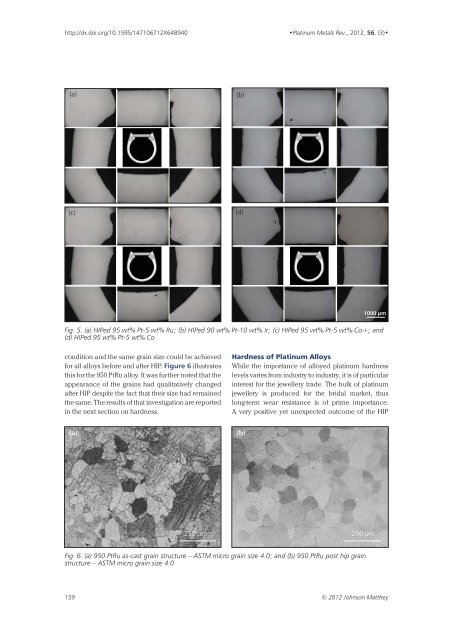Download article PDF - Platinum Metals Review
Download article PDF - Platinum Metals Review
Download article PDF - Platinum Metals Review
You also want an ePaper? Increase the reach of your titles
YUMPU automatically turns print PDFs into web optimized ePapers that Google loves.
http://dx.doi.org/10.1595/147106712X648940<br />
•<strong>Platinum</strong> <strong>Metals</strong> Rev., 2012, 56, (3)•<br />
(a)<br />
(b)<br />
(c)<br />
(d)<br />
1000 μm<br />
Fig. 5. (a) HIPed 95 wt% Pt-5 wt% Ru; (b) HIPed 90 wt% Pt-10 wt% Ir; (c) HIPed 95 wt% Pt-5 wt% Co+; and<br />
(d) HIPed 95 wt% Pt-5 wt% Co<br />
condition and the same grain size could be achieved<br />
for all alloys before and after HIP. Figure 6 illustrates<br />
this for the 950 PtRu alloy. It was further noted that the<br />
appearance of the grains had qualitatively changed<br />
after HIP despite the fact that their size had remained<br />
the same. The results of that investigation are reported<br />
in the next section on hardness.<br />
Hardness of <strong>Platinum</strong> Alloys<br />
While the importance of alloyed platinum hardness<br />
levels varies from industry to industry, it is of particular<br />
interest for the jewellery trade. The bulk of platinum<br />
jewellery is produced for the bridal market, thus<br />
long-term wear resistance is of prime importance.<br />
A very positive yet unexpected outcome of the HIP<br />
(a)<br />
(b)<br />
250 μm 250 μm<br />
Fig. 6. (a) 950 PtRu as-cast grain structure – ASTM micro grain size 4.0; and (b) 950 PtRu post hip grain<br />
structure – ASTM micro grain size 4.0<br />
159 © 2012 Johnson Matthey
















